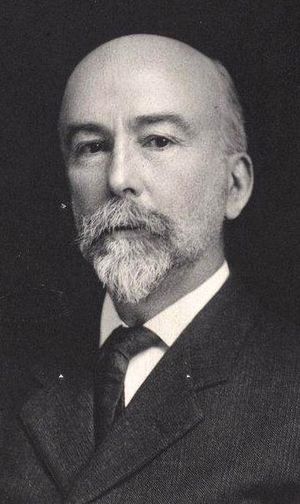William Morris Davis facts for kids
Quick facts for kids
William Morris Davis
|
|
|---|---|
 |
|
| Born | February 12, 1850 |
| Died | February 5, 1934 (aged 83) |
| Known for | cycle of erosion; peneplains; often called the "father of American geography" |
| Relatives | Edward M. Davis (father) Maria Mott Davis (mother) |
| Awards | Hayden Memorial Geological Award (1917) Vega Medal (1920) Penrose Medal (1931) |
| Scientific career | |
| Fields | Geography, Geomorphology, Geology, Meteorology |
| Influenced | Charles Cotton Jovan Cvijić Douglas Wilson Johnson Walther Penck Hans Reusch Walter Wråk |
William Morris Davis (February 12, 1850 – February 5, 1934) was an important American scientist. He was a geographer, geologist, geomorphologist, and meteorologist. Many people call him the "father of American geography" because of his big impact on the field.
Davis was born in Philadelphia, Pennsylvania. His family were Quakers, a religious group known for their simple lifestyle. His mother, Maria Mott Davis, was the daughter of Lucretia Mott, a famous supporter of women's rights.
He studied geology and geography at Harvard University. After graduating, he joined an expedition to the Colorado territory. This trip helped explore the Rocky Mountains. He later became a teacher at Harvard.
Davis was married three times. His first wife was Ellen B. Warner. After she passed away, he married Mary M. Wyman in 1914. Later, in 1928, he married Lucy L. Tennant, who survived him. He died in Pasadena, California, just before his 84th birthday. His home in Cambridge is now a National Historic Landmark.
Contents
William Morris Davis's Scientific Work
Early Career in Meteorology
Davis started his career as a meteorologist in Córdoba, Argentina. He worked there for three years. After that, he became an assistant to Nathaniel Shaler, another well-known scientist. In 1879, Davis began teaching geology at Harvard. Even though he never earned a PhD, he became a full professor in 1890. He continued to teach and study throughout his life.
Understanding How Landscapes Change
Davis was very good at observing nature and thinking logically. He combined his own observations with studies from other scientists. This helped him create his most famous idea: the "geographical cycle".
His theory, first explained in 1889, describes how rivers shape land over time. It was inspired by the ideas of Charles Darwin and Jean-Baptiste Lamarck. Davis suggested that large rivers go through three main stages:
- Youthful stage: Rivers are fast, cutting deep valleys. They might have waterfalls and rapids.
- Mature stage: Rivers flow more slowly, creating wider valleys. They start to meander (curve).
- Old-age stage: Rivers move very slowly across flat plains. They form wide floodplains and oxbow lakes.
Each stage has different landforms. These stages can be seen along different parts of a single river, from its source to its mouth.
Criticism and Modern Views
While Davis's cycle of erosion was important for geomorphology (the study of landforms), some later scientists criticized his ideas. When he retired in 1911, his theories were very popular. Davis often reacted strongly to criticism, especially from German scientists like Walther Penck.
Today, with new ideas like modern tectonic theory, scientists see Davis's and Penck's ideas as more compatible. Davis's ideas might fit better where land is changing quickly due to plate movements. Penck's ideas might be better for areas where land changes more slowly.
Contributions to Geography and Social Ideas
In 1904, Davis helped start the Association of American Geographers. He was also very involved with the National Geographic Society. He wrote many articles for their magazine. In 1911, he became the president of the Geological Society of America. He received the Patron's Medal from the Royal Geographical Society in 1919.
Davis wrote a textbook called Elementary Physical Geography (1902). In one chapter, he discussed how physical geography might affect "human progress." Unfortunately, Davis's writings included ideas that are now called scientific racism. He suggested that certain groups of people were more "advanced" based on their race and environment. These ideas were influenced by his mentor, Nathaniel Shaler. Davis used ideas from Darwin's biology and applied them to human societies. This way of thinking is sometimes called "environmental determinism." It suggests that the environment completely determines human culture. His student, Ellsworth Huntington, also explored these ideas.
Legacy and Recognition
The valley of Davisdalen in Nathorst Land at Spitsbergen, Svalbard is named after William Morris Davis. This shows his lasting impact on the field of geography.
Works
Books:
- Elementary Meteorology (Boston, Ginn & Company, 1893)
- Elementary Physical Geography (Boston, Ginn & Company, 1902)
- Geographical Essays (Boston, Ginn & Company, 1909)
Articles:
- "Geographic methods in geologic investigations", National Geographic Magazine 1: pp. 11–26 (1888)
- "The Rivers and Valleys of Pennsylvania", National Geographic Magazine 1: pp. 183–253 (1889)
- "The geographical cycle", Geographical Journal, vol. 14, pp. 481–504 (1899). Accessible from JSTOR
- "The Physical Geography of the Lands", Popular Science Monthly 2: pp. 157–170 (1900)
Images for kids
See also
 In Spanish: William Morris Davis para niños
In Spanish: William Morris Davis para niños


